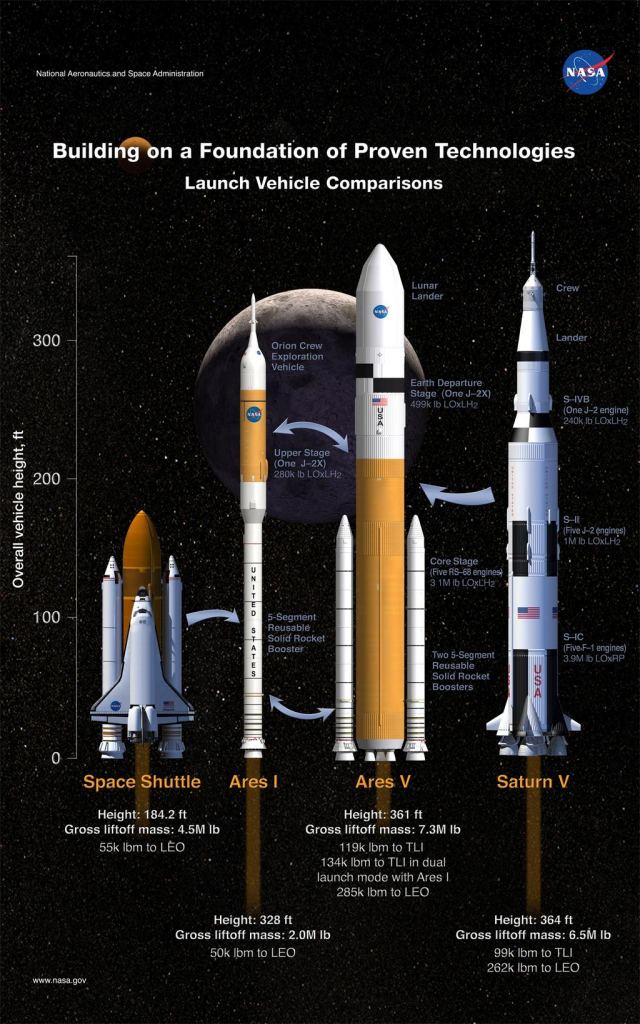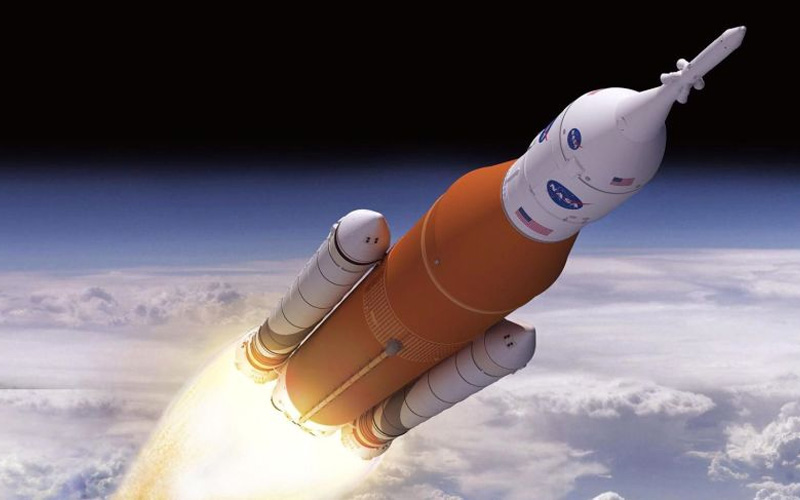A dramatic week in space launcher politics has left NASA’s Space Launch System (SLS) with a vastly reduced launch manifesto and casts doubt on the prospects of future upgrades to the massive launch vehicle.
On Monday the White House’s budget request laid out the administration’s plans for NASA’s coming years. For SLS there were three significant changes.

Firstly, the budget request deferred the development of upgrades from the the initial Block 1 design to future years, with the agency instructed to focus on getting the vehicle flying first. In its current form, the upper stage is called the Interim Cryogenic Propulsion Stage (ICPS) and it’s essentially a repackaged version of a Delta IV upper stage using a single RL-10 engine fueled by 25 tons of propellant. With this upper stage, the SLS is able to send the Orion Capsule and its service module around the moon.
This is sufficient for the first two planned SLS missions, Exploration Mission 1 & 2 (EM-1 & EM-2), first sending an uncrewed capsule on month long excursion to cislunar space in 2020, and subsequently sending a crew on a similar voyage in 2022.

Beyond this, the plan had been to develop SLS Block 1B which would have an upgraded 2nd stage powered by 4 RL-10 engines and carrying over 100 tons of propellant. This upper stage would be able to launch an Orion and a module for the Lunar Gateway on the same lunar trajectory. Without the EUS the SLS becomes a more limited launch vehicle.
The second big change to SLS is a direct consequence of the EUS being unavailable, launches of lunar gateway components would be switched to commercial launch providers like ULA, SpaceX and potentially Blue Origin. While the language of the budget request pushes back development of the EUS, it removes any need for it in any future plans.
The third change is to the Europa Clipper mission, which had been funded with a stipulation that it be flown on the SLS. The request asks for the Clipper mission to be launched on board a commercial rocket and justifies this by pointing out this switch will save $600 million over the SLS launch. The specific commercial launch vehicle which might be used is not specified, but the Falcon Heavy is the most capable commercial launch vehicle likely to be available in the planned window.

Even the Falcon Heavy in fully expendable mode would not be able to carry Europa Clipper on the direct Jupiter trajectory desired. With an added kick stage in the form of a Star 48BV it could send the ambitious space probe on a trajectory which could reach Jupiter after a single gravity assist from Earth. The downside to this is the mission will take longer to get there, but that still might be faster than waiting for SLS.
However these changes were not the only bombshell that would be dropped on SLS. On Wednesday NASA Administrator Jim Bridenstine stated that launching the first Orion mission by June 2020 had become so critical that NASA had begun investigating plans to fly this mission on a commercial rocket. Prior to this most people thought that the SLS missions with Orion had remained secure. As of right now, no commercial rocket has the ability to launch the full 25-ton Orion spacecraft with its service module around the moon.

To carry out the EM-1 mission without SLS would require 2 launches, one carrying Orion and its SPS, and a second carrying an upper stage with sufficient propellant to boost these into a trans-lunar injection orbit. These would dock together in low Earth orbit and then begin Orion’s month long ‘Exploration Mission’. This maneuver which brings back early Apollo plans for Earth orbit rendezvous, which were considered safer compared to that ‘crazy’ lunar orbit rendezvous concept that nobody expected to work.
While this statement did prompt a lot of rocket fans to start theorycrafting missions (I myself prototyped a plan using Kerbal Space Program), more sensible individuals felt that this was more likely rhetorical. There have been rumors that EM-1 had been likely to slip past its current June 2020 launch date, already delayed from the original plan. The main roadblock to progress being Boeing’s slow progress on the core stage, with the projected delivery date slipping from June 2017 to December 2019.
On Friday morning this was made clear when Jim Bridenstine tweeted an update:
Good news: The @NASA and Boeing teams are working overtime to accelerate the launch schedule of @NASA_SLS. If achievable, this is the preferred option for our first exploration mission that will send the @NASA_Orion capsule around the Moon. Still looking at options.
— Jim Bridenstine (@JimBridenstine) March 15, 2019
So for now it seems that SLS is still on the cards, but it’s clear that patience is running out.
While these changes look like a disaster for SLS, it should be understood that this budget request is merely that. The budget is created by Congress, which will be almost certainly make huge changes to these plans as individual politicians try to craft budgets to benefit their local interests. The SLS is the poster child for this kind of process, and owes its continued existence to politicians like Senator Richard Shelby of Alabama. SLS development is lead by the Marshal Space Flight Center in Alabama, so there will continue to be local support for this program regardless of what the POTUS wishes.
The history of the SLS makes this even more clear, before the SLS program officially started with the 2010 budget there was the Constellation Program which started in 2005. It included the Orion crew capsule and a pair of rockets: Ares I and Ares V. Like the SLS, these rockets were designed around components used on the space shuttle, but assembled in a more sensible manner. The large solid rocket boosters strapped to the sides of a distinctive orange hydrogen/oxygen propellant tank, but with the engines attached to the bottom of the tank and the payload on top. It was argued that reusing this technology would accelerate development while maintaining existing contracts with suppliers (and their lobbyists).

In 2009, the program was appraised by the Review of United States Human Space Flight Plans Committee, lead by Norman Augustine. The committee found that the Constellation program was in trouble and not on course to achieve its goals without a massive increase in funding. In 2010, the budget removed the Constellation program effectively killing it, but support within Congress resulted in a compromise which saw Constellation reborn as SLS. The majority of the workers, contractors and hardware involved switched without pausing.
The transition from Constellation to SLS did kill the Ares I rocket which was supposed to launch the Orion capsule to the ISS. A demonstration of this had flown a single launch, but there were concerns design. For the crew the vibration levels from the solid rocket motor were expected to be so powerful that it would make the cockpit scenes in ‘First Man’ feel calm. The 45th Space Wing published an infamous safety study titled “Capsule ~100%-Fratricide Environments” showing that if the abort system was used in the first minutes of flight the parachutes on the capsule would be destroyed by burning fragments of solid fuel.
Instead, the 2010 budget pushed forward with the Commercial Crew Development Program, a bold plan to launch astronauts to low Earth orbit using commercial rockets. Earlier this month we saw the first launch of this program with SpaceX’s Dragon 2 capsule visiting the ISS and returning safely to Earth. In the coming months we expect Boeing to launch their Starliner capsule on board a ULA Atlas V, and both should launch crew to the ISS by the end of the year.
It’ll be great to see humans flying to orbit, on US built vehicles again, but it’s even more amazing to see this in light of how the programs have been funded for the last few years. In 2015 the Senate’s Commerce, Justice and Science Subcommittee cut commercial crew’s funding citing projected delays as a reason, by comparison the same committee recommended SLS funding increases to keep it on schedule. The Senator in charge of that committee was Richard Shelby of Alabama.
Four years later, Commercial crew is flying and SLS is pushing out timelines and scaling back expectations, but its allies are no doubt already making plans.

